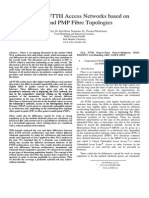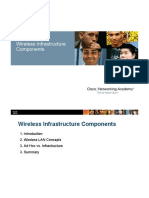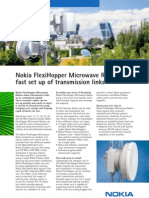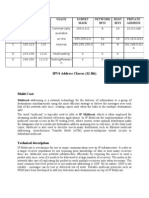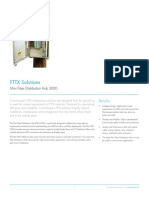Fibre To BTS
Fibre To BTS
Uploaded by
Pravesh Kumar ThakurCopyright:
Available Formats
Fibre To BTS
Fibre To BTS
Uploaded by
Pravesh Kumar ThakurOriginal Title
Copyright
Available Formats
Share this document
Did you find this document useful?
Is this content inappropriate?
Copyright:
Available Formats
Fibre To BTS
Fibre To BTS
Uploaded by
Pravesh Kumar ThakurCopyright:
Available Formats
FIBRE TO THE BTS IMPROVING NETWORK FLEXIBILITY & ENERGY EFFICIENCY
(Study Paper by FLA Division)
Ram Krishna Dy. Director General (FLA) TEC New Delhi, DoT, Govt. of India. E-mail: ddgfla.tec@gov.in
Mrs. Laxmi Director (FLA) TEC New Delhi, DoT, Govt. of India E-mail: dirngn2.tec@gov.in
Abstract
Over the last few years, the use of fiber optic cable in place of more conventional coaxial cable has become viable in many applications due to advances in analog fiber technology. This paper presents Fiber-to-BTS i.e. Fiber in Base station Applications, a new system for feeding radio frequency (RF) signals from either the base station controller (BSC) or base transceiver station (BTS) directly to the antenna element at the air interface. RF system designers are familiar with the two major limiting characteristics of coaxial cables: the increase in RF loss with frequency and length. This type of system has lower transmission losses and greater power efficiency than current state-of-the-art implementations. Other advantages include fast antenna main beam steering, reduced antenna weight, and reduced susceptibility to RF interference on the feeder network and simplified site installation.
1.
Introduction
The enormous increase in cellular telephone usage has created demand, additional network capacity and bandwidth. Cellular network capacity growth is driven by new cell phone functions and services like video streaming, web browsing, email and text messaging. Base Station Transceivers with greater bandwidth are in demand. Fiber optic links give cost effectiveness, high bandwidth new capacity with more flexibility than copper links. Fiber links make system modifications and future upgrades simpler than would be possible with traditional copper links. It can easily integrate into existing systems enabling gradual roll-out where required. In addition, Fiber features inherent data security and superior reliability in hostile environments.
Page 1 of 7
Fiber-to-BTS eliminates the requirement of bulky feeder cables from the BTS to the antenna, and within the antenna itself, by replacing them with an optical feed.
2.
2.1
Where does Fiber fit in?
Fiber from BSC to BTS
The BTS is typically located in a high location, on the top of a building or on a free standing mast, so the antenna has a clear view of the widest possible area for maximum radio coverage. Exact placement of the BTS and associated antennas should be dictated by maximum signal coverage and optimum signal integrity. The BSC can then be located at an accessible location, on the ground or in the basement of the building; such locations allow the BSC to easily access the public network already in place and provides access for maintenance and upgrades of the connection to the public network.
Historically, the BSC has been within a few hundred meters of the BTS and often in a one-to-one relationship. The data rates for communicating between the two have been relatively low. As the need for higher densities of BTS develop and as wireless network
Page 2 of 7
use increases, the need for higher data rates and higher data bandwidth between the BTS and the BSC has become apparent.
With fiber connections, the locations can be selected that optimize the connections of a single BSC with several BTSs; the capability is especially useful with the extra distance made possible by fiber connections as compared to legacy copper connections. Furthermore, the BSC can be located in a more environmentally friendly environment as well as allowing more security for the node that is attaching to the public telecommunication system. Fiber works well as a connection between the BTS and the BSC.
Fiber connections can also be used for the connection from one BTS to another, giving the Base Station system engineer greater design flexibility. Fiber leads to a more flexible and scalable infrastructure.
2.2
Fiber to the antenna
The radio cell sizes of modern mobile communications systems are becoming increasingly smaller due to increasing data rates, higher transmission frequencies and the increase volume of data. Whereas GSM works predominantly in lower frequency bands around 900 MHz, the new systems use the higher available frequency bands at 2.1 GHz, 2.5 GHz and 3.5 GHz. However the propagation losses increase with the square of the frequency, which means that the new systems require smaller radio cells
Page 3 of 7
in order to be able to guarantee equivalent network coverage. Another non system related factor is the increasing number of cell phone subscribers and the constantly increasing volume of data due to new services.
Conventional cellular network architectures with copper wire links between the base station and the cell-site antenna can no longer support this trend in a cost efficient way and are also no longer competitive. The most modern mobile communication systems now use fiber optics for the link from the base station to the antenna. Base stations of conventional mobile communication systems modulate the data into the allocated frequency band and subsequently power amplify the high frequency signals. These output signals are transmitted via coaxial cables to the antenna which emits the signal into the radio cell. The transmission distance via coaxial cables is limited to less than fifty meters, as the coaxial cables are very prone to losses, which have a negative impact on the radio cell coverage and the data throughput. Generally, a base station supplies 3 to 6 antennas.
With Fiber to the Antenna, the entire high frequency and power electronics are taken from the base station and located at a remote-radio head close to the antenna. This remote radio head (RRH) is linked to the base station by fiber optic cables. The entire base station control and the base band signal processing continue to take place in the base station, where the last unit, an SFP transceiver, carries out electro optical data conversion. The optical data is transmitted at typical data rates of one gigabit per second to radio head-end, which converts the optical signal back into an electrical signal by
Page 4 of 7
means of second SFP module, prior to high frequency modulation and final power amplification. The radio frequency is transmitted to antenna via short coaxial cables, so called jumpers, before being emitted from the antenna. Through FTTA systems, the transmission distance can increase between base station and remote radio heads, allowing more innovative network architectures (e.g. chaining of RRHs), and have considerable cost benefits in terms of both installation and operation.
3.
Fiber Optic Transceiver
The fiber optic transceiver is a component that transmits and receives a digital optical signal that travels along optical fibers. Optical fiber is essentially an optical waveguide. RF signals exchanged over the fiber network must be digitized and serialized. This is facilitated by the deployment of high speed D/A and A/D converters that allow the digitization of an entire cellular band. The fiber optic link consists of two channels for the so called uplink and downlink which is implemented with single mode or multimode fibers.
4.
1.
Advantages of Fiber in BTS
The most obvious advantage of a fiber connection over a copper based solution is the elimination of a potentially conducive path between the BTS and BSC. Lightening is commonly drawn to high, conducting antenna structures; with fiber, lightening strike induced system effects are minimized.
2.
In addition, potential damage from Electro Static discharge, ESD, is also minimized with fiber.
3.
Furthermore, the electromagnetic properties of fiber differ from those of copper. As a result, using fiber for this link reduces the incidence of EMI, Electromagnetic interference. Similarly, the data transmitted along the fiber will not emit any extraneous electromagnetic RF energy.
4.
Fiber cabling is more lightweight and takes less space to run, especially when compared to copper links at high data rates.
5.
Fiber is transmission energy efficient. By eliminating coaxial cable losses from BTS to the air interface, transmitted power can be reduced by a third while maintain the same EIRP
6.
As the data rate increases, system upgrades are generally easier with fiber than with copper cabling. Fiber links can easily handle provides the increased capacity to carry the high bit data rates over long distances
Page 5 of 7
7.
Fiber to the BTS can be selectively integrated into any existing cellular infrastructure enabling gradual roll out where required and does not require an upgrade of the BTS
8.
With the use of Fiber in BTS, the system has lower transmission losses and greater power efficiencies using 30% to 40% less energy than current state- of art systems and hence saving power. This is due to fact that fiber optic transceivers have low power requirements less than 1 watt. Furthermore, at higher data rates, increased losses in copper require more power to drive signals, so there is a notable power savings in the fiber optic links. Thus it significantly reduces the power consumption of Radio Access Networks leading to the concept of so called Green Radio.
5.
1.
Limitations/challenges of Fiber Optic link
One challenge from the perspective of Fiber to the BTS is the location of radio head and fiber optic transceiver in a harsh outdoor environment - especially severe weather at elevated, exposed heights. The components must operate over extreme environmental conditions, over a wider temperature range. The typical BTS application requires a fiber transceiver to operate over a range of 40 degree Celsius to 85 degree Celsius temperature.
2.
The power supply to the Transceivers must be stable and noise free in order to maintain error free performance for the data passing through fiber optic link.
6.
Future Scenario
Next generation networks are creating a new model to deploy cellular stations by combining fiber optics with current BTS technology. Next Generation networks is splitting the base station, keeping only the necessary pieces in the remote location, and allowing the rest of the BTS to be places in a centralized facility. He two pieces are connected over a fiber optic link. Next Generation Networks is in the business of creating, implementing, and maintain cellular fiber networks. Such an implementation has two major markets, urban areas where metro fiber rings are laid to deploy new capacity and rural/suburban markets where fiber is used to expand the coverage.
The core of the Next Generation architecture will be that a BTS is located in one position, and then optical fiber is used to connect the BTS to a remotely located antenna. The remote antenna is placed at a desired transmission/reception point. For example, to cover a rural village, a BTS can be placed at an edge and fiber used to connect multiple
Page 6 of 7
radios at poles/buildings. Such a topology offers a much more reasonable cost of coverage than placing multiple base stations throughout the village.
In addition to this, cellular sites require backhaul of the voice signals back to MSC. Backhaul costs are significant fraction of overall cellular operating costs, requiring many E-1 links per base station and these data rates will dramatically increase with 3G and 4G networks. By aggregating the backhaul through Fiber in the BTS applications, backhaul, the lower cost/bit of higher bit rate carriers can also be achieved in addition to extremely high backhaul rates.
7.
Conclusion
The rapid expansion of wireless telecommunications networks, including cellular phone and data services, measured either by data volume or bandwidth, means fiber optic transmission technology will be a significant part of the future systems. Engineers are becoming more familiar and comfortable with fiber solutions. In addition to filling a niche for more flexible network architecture and usage, several additional advantages arise from the use of fiber connections within Base Station systems, such as EMI resilience and data security.
References
1. Fiber Optic Tranceivers in Basestation Applicatuons, white paper by Avago Technologies 2. Fiber to the Antenna, GR No. TEC/GRE/TX/FTA-01/01, Mar-11 by Telecom Engineering Centre, Govt. of India 3. Transmission or WiFi/Cellular/PCS over a common infrastructure, Technology White Paper by Sanjay Mani, Ph.D. Director of R&D, NextG Networks 4. FTTA Fiber-To-The- Antenna-Technology Change in Mobile Communiactions, by Dr. Martin Strasser,Produkt Marketing Manager, HUBER+SUHNER Switzerland
Page 7 of 7
You might also like
- Traditional 100G Bulk OTN Encryption: Single Customer, WavelengthDocument1 pageTraditional 100G Bulk OTN Encryption: Single Customer, WavelengthkapakdoonNo ratings yet
- Loop Qualification For VDSL2Document77 pagesLoop Qualification For VDSL2dchardwareNo ratings yet
- Comparing FTTH Access Networks Based On P2P and PMP Fibre TopologiesDocument9 pagesComparing FTTH Access Networks Based On P2P and PMP Fibre TopologiesWewe SlmNo ratings yet
- Self-Paced Volte & The Ims Training: 16 Hour Course - LectureDocument4 pagesSelf-Paced Volte & The Ims Training: 16 Hour Course - LecturePravesh Kumar ThakurNo ratings yet
- ANT ASI4518R39v07 3874 DatasheetDocument3 pagesANT ASI4518R39v07 3874 DatasheetRobert75% (4)
- Radio Spectrum Management: Policies, Regulations and TechniquesFrom EverandRadio Spectrum Management: Policies, Regulations and TechniquesNo ratings yet
- OptiXstar HG8147X6Document3 pagesOptiXstar HG8147X6Firmino China ManuelNo ratings yet
- Bktel FTTH SolutionsDocument9 pagesBktel FTTH SolutionsVivin ViolitaNo ratings yet
- En-Fiber Optic Pre-Connectorized SolutionDocument44 pagesEn-Fiber Optic Pre-Connectorized SolutionbashkimNo ratings yet
- Huawei OptiX OSN 550Document2 pagesHuawei OptiX OSN 550farhanwaliNo ratings yet
- GPON Solution - Online TrainingDocument72 pagesGPON Solution - Online TrainingApichai ThitiNo ratings yet
- Passive Optical Network (PON) TopologiesDocument31 pagesPassive Optical Network (PON) TopologiesSudhashree MutuswamyNo ratings yet
- Cu7103 Optical Networks SyllabusDocument1 pageCu7103 Optical Networks Syllabusroshan2468No ratings yet
- Advantages of G655 Fiber Over G652 FiberDocument6 pagesAdvantages of G655 Fiber Over G652 Fibercarlosmena1987No ratings yet
- The Basics of FTTHDocument36 pagesThe Basics of FTTHFanny Tampubolon100% (1)
- Cables and Connectors Printed Circuit Boards (PCBS) Packaging of Components & Ics Electronic InterconnectionsDocument35 pagesCables and Connectors Printed Circuit Boards (PCBS) Packaging of Components & Ics Electronic InterconnectionsARAVINDNo ratings yet
- Microwave Communication PrinciplesDocument33 pagesMicrowave Communication PrinciplescopmashNo ratings yet
- III Module - A Survey On 4G-5G Dual Connectivity - Road To 5G ImplementationDocument18 pagesIII Module - A Survey On 4G-5G Dual Connectivity - Road To 5G ImplementationJoathan LessaNo ratings yet
- ADSLDocument31 pagesADSLpraveenpv7No ratings yet
- DslamDocument2 pagesDslamIslam AhmedNo ratings yet
- Fiber To The AntennaDocument20 pagesFiber To The AntennaNuno FernandesNo ratings yet
- Prepared By: Naveen KumarDocument28 pagesPrepared By: Naveen KumarmintoissacNo ratings yet
- Basic Knowledge About WDM Principle ADocument92 pagesBasic Knowledge About WDM Principle AJosé LópezNo ratings yet
- Accessories: Europe/Middle East/Africa Product Selection GuideDocument68 pagesAccessories: Europe/Middle East/Africa Product Selection GuideShiela Monique FajardoNo ratings yet
- Radio Over Fiber Technology For Wireless AccessDocument6 pagesRadio Over Fiber Technology For Wireless AccessAnuj Pathak BallanNo ratings yet
- NEATEL - Outdoor FTTX Precon Solutions and ProductsDocument25 pagesNEATEL - Outdoor FTTX Precon Solutions and Productsmarklok2001No ratings yet
- FTTX - PON Technologies and Its RequirementsDocument33 pagesFTTX - PON Technologies and Its RequirementsMohamed ShabanaNo ratings yet
- 03 Wireless Infrastructure ComponentsDocument28 pages03 Wireless Infrastructure ComponentsAdnen RouatbiNo ratings yet
- Televes OLT512 Optical Line TerminalDocument1 pageTeleves OLT512 Optical Line TerminalBastian AtenasNo ratings yet
- DWDMDocument41 pagesDWDMKarthik KompelliNo ratings yet
- FTTH-ODN - Optical Fiber Networks Fundamentals (Part 1)Document21 pagesFTTH-ODN - Optical Fiber Networks Fundamentals (Part 1)Mohamed Shabana50% (2)
- Difference Between OM1, OM2, OM3, OM4 and OM5 Multimode Fibers - CablekDocument2 pagesDifference Between OM1, OM2, OM3, OM4 and OM5 Multimode Fibers - CablekJemerald MagtanongNo ratings yet
- Huawei Future Oriented FTTxSolutionDocument30 pagesHuawei Future Oriented FTTxSolutionokakaNo ratings yet
- EXFO Technical Note 38Document8 pagesEXFO Technical Note 38accumulatorNo ratings yet
- FH DatasheetDocument2 pagesFH DatasheetPawanKumar BarnwalNo ratings yet
- UMTS Link BudgetDocument10 pagesUMTS Link BudgetvishalnirmalNo ratings yet
- 04 Web Fiber Present enDocument34 pages04 Web Fiber Present enmfarouk1No ratings yet
- IPV4 Address Classes (32-Bit) : Class Range First BIT Usage Subnet Mask Network Bits Host Bits Private AddressDocument14 pagesIPV4 Address Classes (32-Bit) : Class Range First BIT Usage Subnet Mask Network Bits Host Bits Private Addressjibrangill100% (1)
- The Difference Between Trunked and Conventional RadioDocument5 pagesThe Difference Between Trunked and Conventional RadioWalter Oluoch OtienoNo ratings yet
- Carrier Ethernet EssentialsDocument24 pagesCarrier Ethernet EssentialsHUgoNo ratings yet
- Design and Analysis of An FTTH-GPON in A ResidentiDocument10 pagesDesign and Analysis of An FTTH-GPON in A ResidentiSaif HassanNo ratings yet
- Digital MW Communication PrincipleDocument113 pagesDigital MW Communication PrincipleBwaiNo ratings yet
- Optical NetworksDocument36 pagesOptical NetworksAnonymous i8jqGxiN9No ratings yet
- FIBER OPTICAL COMMUNICATIONS Extra PDFDocument179 pagesFIBER OPTICAL COMMUNICATIONS Extra PDFanil kumar100% (1)
- OptiX WDM Product System Commissioning-V1.0Document41 pagesOptiX WDM Product System Commissioning-V1.0Elfatih HashimNo ratings yet
- optical fiber book بالعربيDocument57 pagesoptical fiber book بالعربيFares Alariqi83% (6)
- Fiber Optic Network Management - The Ultimate GuideDocument15 pagesFiber Optic Network Management - The Ultimate GuideCristi SueNo ratings yet
- Mimo OfdmDocument20 pagesMimo OfdmNishad MuhammedNo ratings yet
- FTTX Solutions: Mini Fiber Distribution Hub 3000Document5 pagesFTTX Solutions: Mini Fiber Distribution Hub 3000julianNo ratings yet
- Feeder System Installation Procedure - MOPDocument19 pagesFeeder System Installation Procedure - MOPSandeep singh100% (1)
- BSNL S FTTH Plan West d1 07222009Document77 pagesBSNL S FTTH Plan West d1 07222009Ravi ChaurasiaNo ratings yet
- TM 2G3G4G Hardware Installation Guide V1.6 PDFDocument150 pagesTM 2G3G4G Hardware Installation Guide V1.6 PDFjacobus_louw4329No ratings yet
- Fiber Access Solution FTTx-PONDocument39 pagesFiber Access Solution FTTx-PONMohamed Shabana100% (1)
- Fiber Optic CommunicationDocument4 pagesFiber Optic Communicationeaglett100% (1)
- Radio Network Planning and Optimisation for UMTSFrom EverandRadio Network Planning and Optimisation for UMTSJaana LaihoRating: 4.5 out of 5 stars4.5/5 (2)
- Understanding UMTS Radio Network Modelling, Planning and Automated Optimisation: Theory and PracticeFrom EverandUnderstanding UMTS Radio Network Modelling, Planning and Automated Optimisation: Theory and PracticeMaciej NawrockiNo ratings yet
- Honeywell KRA 405BDocument4 pagesHoneywell KRA 405BPravesh Kumar ThakurNo ratings yet
- Industrty Revolution 4.0 - PWCDocument20 pagesIndustrty Revolution 4.0 - PWCPravesh Kumar ThakurNo ratings yet
- Modern Psychological Warfare: A Case Study of IndlDocument1 pageModern Psychological Warfare: A Case Study of IndlPravesh Kumar ThakurNo ratings yet
- AWS InnovateDocument28 pagesAWS InnovatePravesh Kumar ThakurNo ratings yet
- Business Development and Sales SpecialistDocument1 pageBusiness Development and Sales SpecialistPravesh Kumar ThakurNo ratings yet
- Cryptography Lecture 1: Principles and HistoryDocument71 pagesCryptography Lecture 1: Principles and HistoryPravesh Kumar Thakur100% (1)
- SmartSDR Software Users GuideDocument194 pagesSmartSDR Software Users GuidePravesh Kumar ThakurNo ratings yet
- Berkeleyvaritronics 2011 Celldetewolf enDocument2 pagesBerkeleyvaritronics 2011 Celldetewolf enPravesh Kumar ThakurNo ratings yet
- Abiding VoicesDocument164 pagesAbiding VoicesPravesh Kumar ThakurNo ratings yet
- Storage Options JoebaronDocument43 pagesStorage Options JoebaronPravesh Kumar ThakurNo ratings yet
- SG1220W & SG1230W User ManualDocument16 pagesSG1220W & SG1230W User ManualSudheera IndrajithNo ratings yet
- Hindustan Times Delhi2012!09!06 Page4Document1 pageHindustan Times Delhi2012!09!06 Page4Pravesh Kumar ThakurNo ratings yet
- Compendium 2012 PDFDocument294 pagesCompendium 2012 PDFPravesh Kumar ThakurNo ratings yet
- Rohde SU155Document5 pagesRohde SU155Pravesh Kumar ThakurNo ratings yet
- The CR Movement in IndiaDocument15 pagesThe CR Movement in IndiaPravesh Kumar ThakurNo ratings yet
- SR Managment ADmin28032016Document2 pagesSR Managment ADmin28032016Pravesh Kumar ThakurNo ratings yet
- Isro 2014-15Document153 pagesIsro 2014-15Jayamurugan RavichandranNo ratings yet
- West Zone Region ServicesDocument3 pagesWest Zone Region ServicesPravesh Kumar ThakurNo ratings yet
- Vividh Bharati FM ServiceDocument2 pagesVividh Bharati FM ServicePravesh Kumar ThakurNo ratings yet
- CDX 308MDDocument42 pagesCDX 308MDRodolfo LozaNo ratings yet
- PseDocument7 pagesPseLUZ ESPINOSANo ratings yet
- Especificaciones DS-2CV1021G0-IDW1Document4 pagesEspecificaciones DS-2CV1021G0-IDW1GabrielNo ratings yet
- Implementas API Bot Telegram Untuk Sistem Notifikasi Pada The Dude Network Monitoring SystemDocument7 pagesImplementas API Bot Telegram Untuk Sistem Notifikasi Pada The Dude Network Monitoring SystemDellya Sari AndiniNo ratings yet
- Wireless Commn - MCQ-1Document18 pagesWireless Commn - MCQ-1dr mbaluNo ratings yet
- Analog and Digital Communication-S1Document16 pagesAnalog and Digital Communication-S1Ezhil Azhahi.AM Assistant ProfessorNo ratings yet
- R18 B.Tech. CSE Syllabus Jntu HyderabadDocument2 pagesR18 B.Tech. CSE Syllabus Jntu HyderabadashrithchanduNo ratings yet
- How To Select A: Motion Control NetworkDocument3 pagesHow To Select A: Motion Control Networkvicky_yánez_7No ratings yet
- Add Info B-82974EN 01Document3 pagesAdd Info B-82974EN 01Charles JacobNo ratings yet
- IOT Based Wireless Sensor Network For Precision Agriculture: AbstractDocument4 pagesIOT Based Wireless Sensor Network For Precision Agriculture: Abstractحسين سعيد حسنNo ratings yet
- Internet Access On Multiple VLANsDocument10 pagesInternet Access On Multiple VLANsanghockbinNo ratings yet
- Sampling Rate and Aliasing On A Virtual LaboratoryDocument5 pagesSampling Rate and Aliasing On A Virtual LaboratoryJaweria AmjadNo ratings yet
- NetplanDocument19 pagesNetplanNyankoye Apollinaire LouaNo ratings yet
- Information and Communication TechnologyDocument18 pagesInformation and Communication TechnologyJhelcy Monique GarnaceNo ratings yet
- Attenuators / Filters / DC BlocksDocument4 pagesAttenuators / Filters / DC BlocksfdyNo ratings yet
- Atlas TransportDocument6 pagesAtlas TransportSyed ShahbazNo ratings yet
- QR 166.04 Overdue QR 166.00 Due 17 September: This Month Amount 166.00 Last Month Outstanding Amount 166.04Document5 pagesQR 166.04 Overdue QR 166.00 Due 17 September: This Month Amount 166.00 Last Month Outstanding Amount 166.04mujahed_muhammedNo ratings yet
- EL3003 - ADC Lab ManualDocument100 pagesEL3003 - ADC Lab ManualMuiz MalikNo ratings yet
- ZXSDR BS8900: Hardware ManualDocument155 pagesZXSDR BS8900: Hardware ManualIgor MagićNo ratings yet
- Introduction To USB Type-C™: Author: Andrew Rogers Microchip Technology IncDocument20 pagesIntroduction To USB Type-C™: Author: Andrew Rogers Microchip Technology IncVarunNo ratings yet
- GSM-R To LTE For Railways in IndiaDocument4 pagesGSM-R To LTE For Railways in IndiaPulin ChaudhariNo ratings yet
- Ug - Jesd204b 683442 782339Document180 pagesUg - Jesd204b 683442 782339Rupak RaviNo ratings yet
- Sol Ch01Document4 pagesSol Ch01Sarop_BajraNo ratings yet
- Annexure-II (6TH SEM UG ECE)Document21 pagesAnnexure-II (6TH SEM UG ECE)Venkatesh ghNo ratings yet
- Fanvil H3 DatasheetDocument2 pagesFanvil H3 Datasheetikponmwosa olotuNo ratings yet
- Sleeping Cell Detection and Recovery (RAN15.0 - 01)Document34 pagesSleeping Cell Detection and Recovery (RAN15.0 - 01)tadjouaminaNo ratings yet
- 3.6.1 Packet Tracer Implement Vlans and TrunkingDocument2 pages3.6.1 Packet Tracer Implement Vlans and TrunkingJohn FrinkNo ratings yet
- TL-WA7510N V1 DatasheetDocument2 pagesTL-WA7510N V1 DatasheetTengis TumurtogooNo ratings yet
- TDE9540 09 WhitePaperDocument56 pagesTDE9540 09 WhitePaperdarkoskr84No ratings yet


